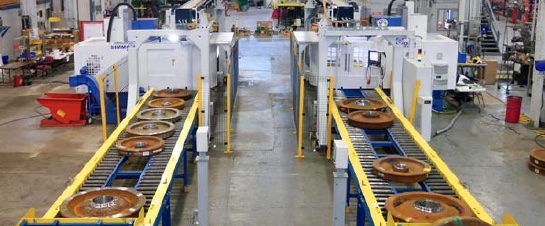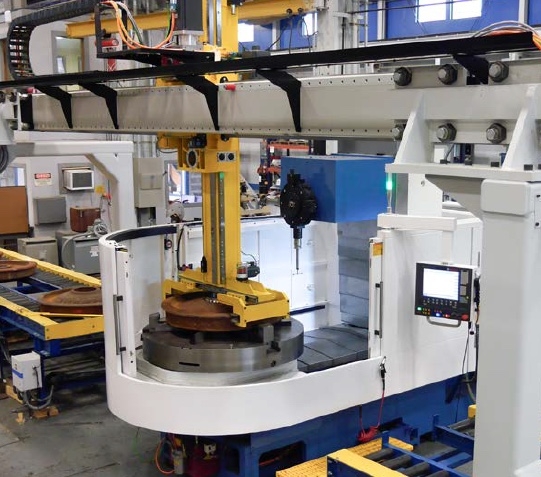Article from Güdel Lineartec (UK) Ltd.
The U.K. has approximately 10,000 miles of railway track on its network while the U.S. boasts over 140,000 miles. One thing that both networks have in common however is the need to maintain and repair the rolling stock, especially the wheels which can be prone to flat spots or other damage causing them to run out of round. In the case of the U.S. however, the scale of the network exacerbates these issues, so to maximise efficiency and productivity in their repair workshops, Simmons Machine Tool Corp. turned to Güdel for a solution.

The maintenance of railway wheel sets represents a significant cost for train operators, as when the wheels of railway carriages have been in service for extended periods they are subject to wear, particularly in the flange and tread areas. This wear makes for less efficient operation, and in extreme cases, can even result in derailments. It’s no surprise therefore to find that automation plays a critical role in both the measurement and maintenance of rail wheel sets.
Simmons Machine Tool Corp., Albany, New York, has been building machine tools, measuring machines and automation systems that focus on the maintenance and production of railway wheel sets since 1910. When the company started designing its new wheel turning center (WTC), a vertical CNC lathe for boring and machining railway wheels, it had two goals in mind. Firstly designing a system that maximizes the safety of both the railway and machine operators and secondly boosting productivity to avoid delays in repairing railway wheels.
When worn wheel sets arrive at a railway wheel maintenance facility, the end caps and bearings are first manually inspected and removed. The serial numbers for each wheel set component are then entered into a supervisory control and data acquisition (SCADA) system. A measurement machine qualifies the parameters of the worn wheel set, and, based on that data, the wheel set is either re-profiled or if the wheel is outside the tolerances set by the Association of American Railroads, the wheels are removed from the axle and scrapped.

A new wheel will then be required. To ensure a precise interference fit between the wheel and axle, the wheel’s center hole must be bored to match the axle wheel seat. Traditionally, each wheel was placed on a machining center using a forklift, crane or other manual material-handling system. The process was slow and inconsistent, and worker safety was a concern.
Today, with the help of Güdel, the Simmons WTC machine cell automates most of the process. Workers load new wheels onto a feeder conveyor, which transports them into an automated material-handling system consisting of a Güdel ZP-6 double-axis gantry with special grippers to handle the heavy wheels.

The system transfers a wheel to the WTC, which bores the center hole of the wheel and several other new features, depending upon the end customer. After boring and/or machining, the wheels are then placed by the Güdel gantry back onto the outbound conveyor for pressing onto an axle. This level of automated material handling creates a more consistent process whist protecting workers from danger when heavy wheels are manipulated in tight spaces. Access to pre- and post-machining measurement data is important to railway companies, as they analyse this data to not only extend the life of wheels, but also the maintenance machines and automation systems.
Automated systems such as this can be deployed throughout a wheel set maintenance or production facility. In addition, they can be networked together to create a closed-loop system, increasing productivity and decreasing the likelihood of operating errors.
“Simmons chose Güdel’s ZP-6 gantry system for this application primarily for its reliability and capability, and because equipment availability is critical for our customers,” said Jason Steven Murphy, marketing specialist at Simmons Machine Tool Corp. “Simmons has a long history of successful projects working with Güdel, and there is a high degree of trust and understanding of each other’s capabilities, which makes projects run smoothly.”
Related Glossary Terms
- boring
boring
Enlarging a hole that already has been drilled or cored. Generally, it is an operation of truing the previously drilled hole with a single-point, lathe-type tool. Boring is essentially internal turning, in that usually a single-point cutting tool forms the internal shape. Some tools are available with two cutting edges to balance cutting forces.
- closed-loop system
closed-loop system
CNC system in which the program output, or the distance the slide moves, is measured and compared to the program input. The system automatically adjusts the output to be the same as the input.
- computer numerical control ( CNC)
computer numerical control ( CNC)
Microprocessor-based controller dedicated to a machine tool that permits the creation or modification of parts. Programmed numerical control activates the machine’s servos and spindle drives and controls the various machining operations. See DNC, direct numerical control; NC, numerical control.
- flat ( screw flat)
flat ( screw flat)
Flat surface machined into the shank of a cutting tool for enhanced holding of the tool.
- lathe
lathe
Turning machine capable of sawing, milling, grinding, gear-cutting, drilling, reaming, boring, threading, facing, chamfering, grooving, knurling, spinning, parting, necking, taper-cutting, and cam- and eccentric-cutting, as well as step- and straight-turning. Comes in a variety of forms, ranging from manual to semiautomatic to fully automatic, with major types being engine lathes, turning and contouring lathes, turret lathes and numerical-control lathes. The engine lathe consists of a headstock and spindle, tailstock, bed, carriage (complete with apron) and cross slides. Features include gear- (speed) and feed-selector levers, toolpost, compound rest, lead screw and reversing lead screw, threading dial and rapid-traverse lever. Special lathe types include through-the-spindle, camshaft and crankshaft, brake drum and rotor, spinning and gun-barrel machines. Toolroom and bench lathes are used for precision work; the former for tool-and-die work and similar tasks, the latter for small workpieces (instruments, watches), normally without a power feed. Models are typically designated according to their “swing,” or the largest-diameter workpiece that can be rotated; bed length, or the distance between centers; and horsepower generated. See turning machine.
- machining center
machining center
CNC machine tool capable of drilling, reaming, tapping, milling and boring. Normally comes with an automatic toolchanger. See automatic toolchanger.
- turning
turning
Workpiece is held in a chuck, mounted on a face plate or secured between centers and rotated while a cutting tool, normally a single-point tool, is fed into it along its periphery or across its end or face. Takes the form of straight turning (cutting along the periphery of the workpiece); taper turning (creating a taper); step turning (turning different-size diameters on the same work); chamfering (beveling an edge or shoulder); facing (cutting on an end); turning threads (usually external but can be internal); roughing (high-volume metal removal); and finishing (final light cuts). Performed on lathes, turning centers, chucking machines, automatic screw machines and similar machines.
